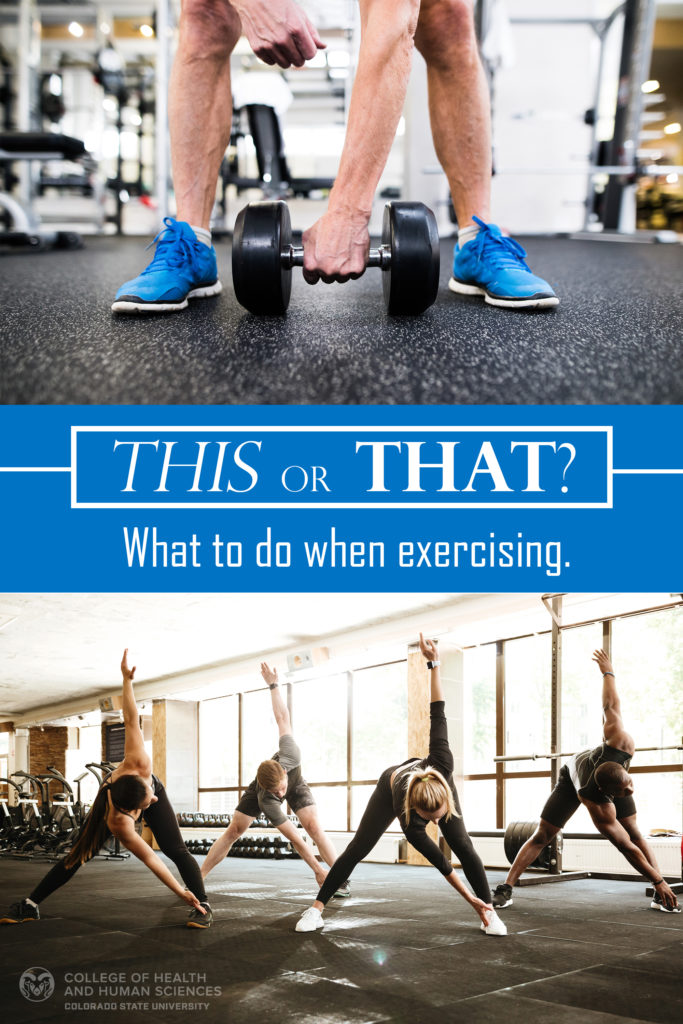When it comes to exercise there is no one size fits all approach. There are debates within the field as to best techniques, practices, and implementation of exercise. So how do you know what’s right for you? Let’s take a deeper look at some of the exercise and fitness areas where we see some of the biggest differences in opinion.
Static vs. Dynamic Stretching
Static stretches are the elongation of the muscle, held for 10-30 seconds, and completed at a challenging yet comfortable range. It should feel like the muscle is lengthening, but it should never be painful. Dynamic stretches are a controlled range of motion stretch where a limb repeatedly moves through the range of motion never holding at the end position. 
Why is there debate? Some research supports the conclusion that static stretching may have protective effects against injury during exercise, while others note that static stretching may actually decrease power and performance when done before exercise. Dynamic stretching generally better mimics movements of exercise and has been thought by some to be more helpful in preparation of exercise, but others state that dynamically stretching a cold muscle creates greater risk for injury.
So, what do you do? The truth is each type of stretch has their own time and place for effectiveness. Dynamic stretches are great after a more thorough body temperature increasing warm-up in preparation for exercise and repeated movements. Static stretching is thought to be the most effective when training to enhance flexibility and should be done at the end of a workout when cooling down.
Low Reps vs. High Reps
Low reps are generally any repetition number under eight, while high repetition numbers are usually in the range of 8-15. The debate is that most strength gains are seen from a higher weight and lower rep range because you should be working at a high volume to fatigue and challenge the muscle. The breakdown of muscle that occurs as a part of the workout will rebuild a bigger and stronger muscle due to the stimulus. This leads some to think that higher repetition ranges don’t really produce strength increases, and are often considered the “toning” range.
Strength training is one of the best forms of exercise to impact daily function and long-term independence, so it should be a part of everyone’s routine. If you look at it as a means to overall better health, it’s best to work in multiple rep ranges over the course of training.
Core Stability vs. Spinal Rotation and Flexion
Some people love crunches and some people hate crunches. Core stability exercises are moves like your standard plank, while crunches, Russian Twists, side bends, and bicycles are core exercises that require flexion and/or rotation of the spine. It is typically best for the spine to stay in a neutral, or straight, alignment. While it is capable of a wide range of motion, should it really be put through that range of motion regularly?
The core is meant to protect the spine and some of the flexion and rotation moves end up exacerbating back pain. That’s not to say that they can’t be done, but perhaps through a shorter range of motion with proper form they can be used as a compliment to core stability exercises that keep the spine in neutral alignment.
Cardio vs. Resistance Training
What’s going to help lose the most weight? What should you do more of, running or lifting?
This has a lot more to do with preference, along with proper training and program planning, than actually answering which is better. Both are safe and effective means of exercise.
Typically, during a single cardio session you’re likely to burn more calories than weight lifting alone. But weight lifting has a greater likelihood of impacting or increasing your resting metabolism levels with the increase of muscle mass associated with this form of training. This higher resting metabolic level means more calories burned in the long run. So what to do? Again, it’s likely best for a well-rounded program and overall health to implement both forms of exercise into your regular routine.
Some people might be at the extremes of exercise and only favor one option, but in the debate of some of the polarizing topics it really seems that each have their place. With proper form and the appropriate selection of exercises for your training and knowledge, you can do a lot, and you don’t have to limit yourself to this or that.
For more health tips, visit the College of Health and Human Sciences Pinterest board.
Kimberly Burke is the director of the Adult Fitness Program at Colorado State University, an outreach program through the Department of Health and Exercise Science. Adult Fitness offers exercise opportunities for employees of CSU as well as community members, while providing hands-on learning experiences for health promotion students. To learn more see http://hes.chhs.colostate.edu/outreach/adultfitness/